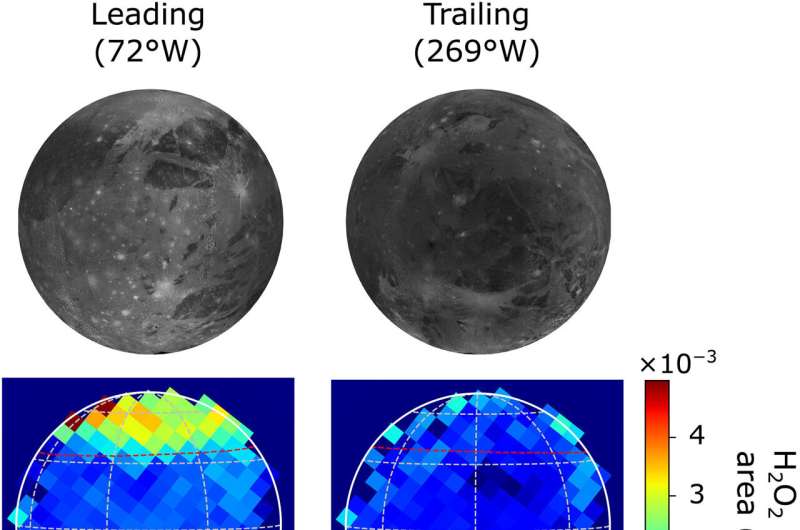July 24, 2023 report
This article has been reviewed according to Science X's editorial process and policies. Editors have highlighted the following attributes while ensuring the content's credibility:
fact-checked
peer-reviewed publication
trusted source
proofread
Hydrogen peroxide found on Jupiter's moon Ganymede in higher latitudes

An international team of space scientists has found evidence that hydrogen peroxide on Ganymede, Jupiter's largest moon, exists only on its higher latitudes. For their research, reported in the journal Science Advances, the group studied data from the James Webb Space Telescope (JWST).
For many years, researchers theorized that hydrogen peroxide existed on Ganymede, but it took a prior team studying data from the JWST to find it. In this new effort, the research team analyzed new data sent back by the telescope to learn more about the surface of the moon and its hydrogen peroxide.
Ganymede is the largest moon in the solar system, but it has not received nearly the attention given to another of Jupiter's moons, Europa, whose features and characteristics make it far more likely to have harbored life at some point in time. But prior research has shown that the influence of Jupiter's magnetic field on many of its moons could indicate a strong probability of hydrogen peroxide on Ganymede. This is because of its likely impact on the water-ice irradiation process on its surface.
Prior research has shown that both Ganymede and Europa are impacted by radiation from Jupiter's magnetosphere—it bombards the surface of both moons, converting water ice into other compounds such as oxygen, ozone and hydrogen peroxide. In this new effort, the researchers studied data from the JWST NIRSpec Integral Field Unit.
The team found a 3.5-micrometer absorption band showing the presence of hydrogen peroxide in the northern parts of the moon, mostly on the side facing directional orbit. They also observed oxygen mostly seen in lower latitudes and on the opposite side of the moon. The findings show a stark contrast between Ganymede and Europa—on Europa, most of its hydrogen peroxide is located near its equator.
The team notes that their findings are part of a larger process geared toward better understanding how Ganymede's magnetic field influences its own surface chemistry.
More information: Samantha K. Trumbo et al, Hydrogen peroxide at the poles of Ganymede, Science Advances (2023). DOI: 10.1126/sciadv.adg3724
Journal information: Science Advances
© 2023 Science X Network





















